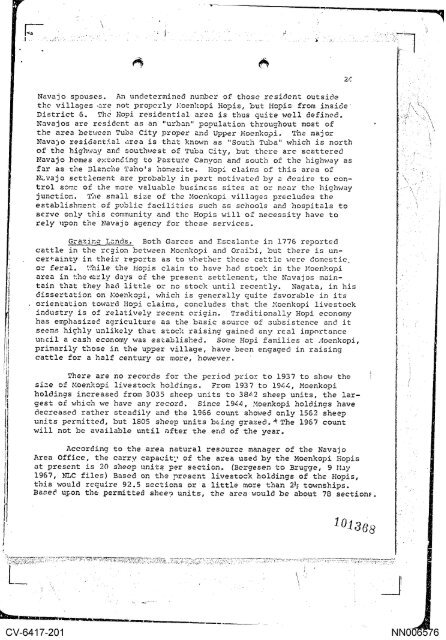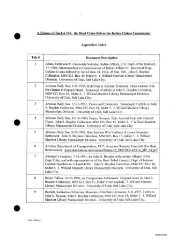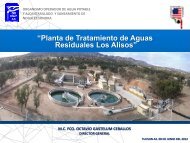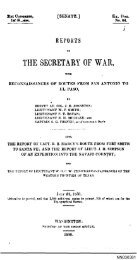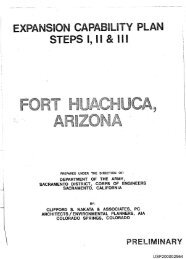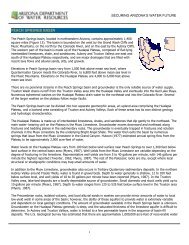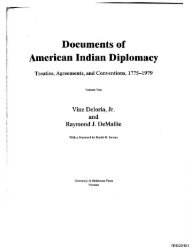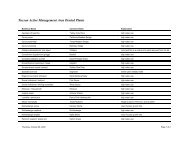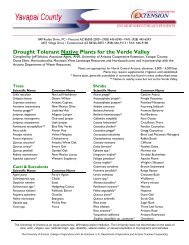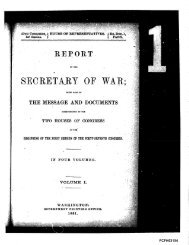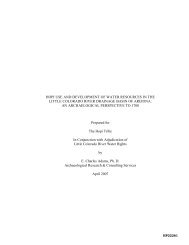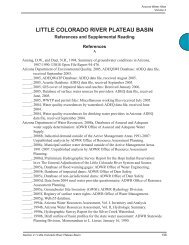By David Brugge - Arizona Department of Water Resources
By David Brugge - Arizona Department of Water Resources
By David Brugge - Arizona Department of Water Resources
You also want an ePaper? Increase the reach of your titles
YUMPU automatically turns print PDFs into web optimized ePapers that Google loves.
Navajo spouses. An undetermined nu~bcr 02 those resident outside<br />
thc villages m e not propc~ly broenkopi Ho~is, but I3opis from inside'<br />
District 6. ~ h lbpi c residential area is thus quite well dcfincd.<br />
Kavajos are resident as an "urhan" poylation throughout most <strong>of</strong><br />
the area between Tuba City proper and Upper Noenko~i. The major<br />
Navajo residsr.tLal drea is that known as "South Tuba" which is north<br />
<strong>of</strong> the highwzy an2 southwest <strong>of</strong> Tuba City, but there are scattered<br />
Navajo homes extenZing to Pasture Canyon and south <strong>of</strong> the highway as<br />
far as the ~12ncile Taho's honeslte. clains <strong>of</strong> this area <strong>of</strong><br />
N~vajo settlement are probably in part motivated by a Zcsire to control<br />
so~c <strong>of</strong> the more valuable business sites at or near the highway<br />
junction. Ti~c small size <strong>of</strong> the ;loenkopi villagcs precludes the<br />
establishnent <strong>of</strong> public facilities such as schools and hospitals to<br />
scrvc only this community snd thc Eopis will <strong>of</strong> necessity have to<br />
rely upon the Navajo agency for these services.<br />
Gra.zi.r,q txds. Both Garces anc? Escalante in 1776 reported<br />
cattle in the rcgion between Moenlcopi and Oraiki, but there is un-<br />
certainty in theix reports as to wl~e'ihcr these cattle were c'omestic,<br />
or feral. Y?hile the Iio,ois claim to have had stock in the I/;oenko~i<br />
area in the early days <strong>of</strong> the present settlement, the Navajos main-<br />
tain that they had little 0;- no stock until recently. Nagata, in his<br />
dissertatior. on b:oenko?i, which is generally quite favorable in its<br />
orientation toward Nopi clains, conclucks that the Xoenkopi livestock<br />
industry is <strong>of</strong> relatively recent origin. Traditionally Hopi economy<br />
has emphasized agriculture as the basic source <strong>of</strong> subsistence acd it<br />
seems hishly unlikely that stock raising gained any real importance<br />
urlcil a cash economy was establisked. Some Hopi families at Aoenkopi,<br />
primarily t5ose In the up?er village, have been engaged in raising<br />
cattle for a half century or more, however.<br />
There are no records for the pexicd prior to 1937 to show the<br />
size <strong>of</strong> Koefikopi livestock holdings. r'rom 1937 to 1944, Moenko;?i<br />
holdings increased from 3035 sheep units to 384.2 sheep units, the lar-<br />
gest <strong>of</strong> which we have any record. Since 1944,, Xoenkopi holdings have<br />
decreased rather steasily and the 1966 count showed only 1562 sheep<br />
units permitted, but 1805 sheep units bcing grazed.*~he 1967 count<br />
will not be available until after the end <strong>of</strong> the year.<br />
According to the area natural resaurcc manager <strong>of</strong> the Na,vajo<br />
Area Office, the carry capacit:? <strong>of</strong> the area used by the Moenkopi Iiopis<br />
at present is 20 sheep units per section. (~crgesen to Bruzge, 9 1.1~~<br />
1967, NLC files) Based on the present livestock holdings <strong>of</strong> the Mopis,<br />
this would require 92.5 sections or a little more than 2; townships.<br />
Base8 upon the permitted shce? units, the area would be about 78 sectionr.


